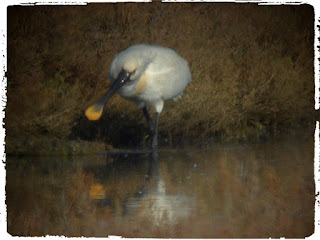Well I couldn't believe that we had a second fantastic day weather-wise, it was superb, so we made the most of it! We left the guest house in the dark at 7am in order to get to the Starling roost by sunrise, which we did with 10 minutes to spare. It was freezing cold but we all wrapped up well so didn't notice it much, the air was still but alive with noise of nearly 1 million chattering starlings.
 |
| sun rise - we arrived to this at 7:20am |
Whilst waiting for the starlings to fly we saw 13 Great White Egrets drop into the marsh with 7 Grey Herons, also Lapwings, Cormorants and several groups of various ducks dashed over us. A couple of early-bird Marsh Harriers also put in an appearance.
As 7:40am they all took off like a plague of locusts bursting from the reedbeds, it was incredible, the noise from their wings sounded like rolling waves on a windy day. It took ten minutes for them all to disperse, it was a truly memorable and fascinating experience, the ultimate natural spectacle, nature at its best, awe inspiring and many more superlatives I can't think of..
=
 |
| a swirling mass of starlings as they erupted from the reeds |
From a slow start we gained momentum with sightings of Common Kingfisher quickly followed by Bearded Tit. The latter showed extremely well down to 3-4 meters but they kept moving.
 |
| Water Rail - as I didn't take any more pictures today the next 5 were taken by Kevin Jones in recent visits to the 'levels' |
 |
| Bittern - swimming - taken by Kevin Jones |
8
 |
| Bittern - not swimming - taken by Kevin Jones |
We drove round to Mudgley to look for Cattle Egrets but none were there, a huge number of Redwings and Fieldfares littered the fields with a single Song Thrush, a couple of Stonechats, a flock of Linnets and two Red Foxes!
 |
| Eurasian Teal - photo by Kevin Jones |
A short drive around Tealham Moor produced sightings of many Lapwings, thrushes, Rooks, Jackdaws and Starlings, but nothing new.
After a short stop in Wedmore where we bought lunch we travelled to Cheddar Reservoir. Our lunch was eaten in the car park as we sat in the lovely sunshine. Birding at the Reservoir was short but sweet, we scoped the whole circular body of water from one point, it was covered in parts with hundreds of ducks, coots and gulls. We added Common Gull, Lesser Black-backed Gull, Goldeneye, Red-crested Pochard but we couldn't find any Goosander that were supposed to be there.
 |
| Great Egrets fighting - phot by Kevin Jones |
We then drove through Cheddar and the famous Gorge but never stopped because it was packed with day trippers that swarmed all over the place, a nightmare.
So back to normality at Chew Valley lake where we spent the last two hours of day light watching thousands or birds from the two causeways, Heron's Green and Herriot's Bridge. Both places provides good sighting and offered opportunities to see one or two rarer birds. We added Black-necked Grebe, Bewick Swan (8), Shelduck and we put a lot of time in looking for Ring-billed and Mediterranean Gulls without reward. We also missed Scaup, Long-tailed Duck, Pink-footed Goose and Goosander because we never had time to drive all the way around this huge man-made lake, another time maybe.
We drove back to our guest house in the dark arriving in good time for another delicious dinner.











































